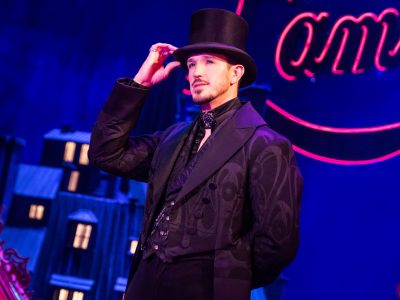There is this concept called a panopticon, first introduced by Jeremy Bentham,” artist Tomas van Houtryve said from the stage at SECCA. “Later Michel Foucault talked about this. This was the idea that you could build the ideal prison where you would have a central watchtower that could see into all of the cells at all times. And what he said was interesting. You would not have to actually watch all the prisoners at all times, they would just have to feel watched and that would be enough to change their behavior.”
Houtryve stood in the auditorium on Nov. 17, presenting an aerial photograph taken by a drone of the infamous Tent City created by Maricopa County Sheriff Joe Arpaio in Phoenix in front of a moderately sized audience. The photo was from “Blue Sky Days,” Houtryve’s contribution to Dispatches, now on display at SECCA through Feb. 19.
“I was given a sheriff’s deputy from the press office to accompany me,” Houtryve told the audience. “I had read in the news that [Arpaio] wanted to get some drones to fly over his prison. I said, ‘Geez with all of these watchtowers, video cameras and fences, why would you even need any drones at this facility?’ And he said, ‘It’s because of the psychological impact.’”
Houtryve is the only participant who has two bodies of work featured in the Dispatches exhibit. Blue Sky Days” and “Traces of Exile” — both funded by grants from the Pulitzer Center on Crisis Reporting — fall into two of the five themes the larger exhibit is divided into: Post-9-11 Realities and Borders & Migration. Ecological Justice, New Forms of Social Action and the 2016 US Presidential Election complete the remaing thematic zones.
While drones may have initially been introduced into society as a tech toy, it didn’t take long for the government and businesses to utilize them for military and commercial use.
“I think that there are some [uses] that are really interesting,” Houtryve said. “But there are a couple of them that really raise questions for me. I don’t think that enough reporting has been done or we have asked ourselves the right questions. This may look cool now, but do we want to have a hostile relationship with the sky that is filled with these devices that can spy on us or can target us. If we let this technology go unchecked, that’s the world we will be living in.”
In “Blue Sky Days,” Houtryve attached a camera to a drone and traveled across America to take aerial pictures of potential terrorist strike targets and other areas where drones aren’t used for combat, such as the Arizona prison. The scenes consist of people praying, taking a walk in a park, working and even attending a funeral. The idea to use a drone itself to tell the story of drone warfare came to him while on a National Geographic photoshoot.
“I have covered several conflicts before, so I watch conflicts around the world and see if there’s a way to cover them,” Houtryve said from the stage. “I had an assignment for National Geographic where I had to take an aerial picture of a mine in Peru and it was at a real high altitude. One of the ideas an engineer had from National Geographic was to use an aerial drone. Since the drone war had been in the back of my mind I said, ‘Hmm, I could use this piece of technology to talk about this thing.’”
There are several reasons that Houtryve felt that it was important to capture and present such images using drone technology.
“It’s a new technology that can be used for new things and bad things,” Houtryve said. “I think what it does is no longer make the sky a neutral place, right? It used to be we would look at the sky and see birds and airplanes but nothing that could bug us or spy on us; now that has changed.”
Drone warfare, in Houtryve’s opinion, is not necessarily limited to airstrikes.
“When I first came up with this project, it definitely meant drones used for warfare overseas in a military capacity to kill people,” Houtryve said. “But there is a conflict and there is a balance of power that has to be shifted based on who’s going to hold on to this technology and who’s going to be able to use it for free speech or for monitoring. That’s not quite war but there is definitely a conflict.”
While Houtryve’s collections are geared towards giving voice to foreign tragedies that are often underreported in the United States — also a common goal of the Pulitzer Center on Crisis Reporting — he is entering a new world of journalism where news media and art collaborate to create a new form of reporting the Pulitzer Center calls “newsart,” which is described as “live news through art.”
“I am heartened by this partnership with art,” Houtryve said. “I feel like there is a real distrust and polarization of the news media. I think you if you can combine the two, you can have important things that are getting stuck or underfunded in the media and bring it to people in a way they can connect with it on a level of beauty.”
Join the First Amendment Society, a membership that goes directly to funding TCB‘s newsroom.
We believe that reporting can save the world.
The TCB First Amendment Society recognizes the vital role of a free, unfettered press with a bundling of local experiences designed to build community, and unique engagements with our newsroom that will help you understand, and shape, local journalism’s critical role in uplifting the people in our cities.
All revenue goes directly into the newsroom as reporters’ salaries and freelance commissions.





Leave a Reply